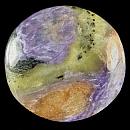|
|
||||||||||||||||
|
||||||||||||||||
|
||||||
|
|
|
|
Canasite
|
|
| | |
| Discovered in 1959; IMA status: Valid (IMA approved) | ||
|
| ||
|
Chemistry |
|
|
| |
|
Na4K2Ca5Si12O30(OH)3F | |
|
|
Sodium Potasium Calcium Silicate Hydroxide Fluoride |
|
Molecular Weight: |
1,257.57 gm |
|
Composition: |
Potassium |
6.22 % |
K |
7.49 % |
K2O |
|
|
Sodium |
7.31 % |
Na |
9.86 % |
Na2O |
|
|
Calcium |
15.93 % |
Ca |
22.30 % |
CaO |
|
|
Silicon |
26.80 % |
Si |
57.33 % |
SiO2 |
|
|
Hydrogen |
0.24 % |
H |
2.15 % |
H2O |
|
|
Oxygen |
41.98 % |
O |
|
|
|
|
Fluorine |
1.51 % |
F |
1.51 % |
F |
|
|
— |
— % |
F |
—0.64 % |
—O=F2 |
|
|
|
100.00 % |
|
100.00 % |
= TOTAL OXIDE |
|
|
|
||||
|
Classification |
|
|
| |
|
Silicates (Germanates) | |
|
8/F.35-10 | |
|
|
9 : SILICATES (Germanates)
|
|
Related to: |
None |
|
Varieties: |
None |
|
Synonyms: |
None |
|
|
|
|
Crystal Data |
|
|
|
|
|
As crystals, to 10 cm; in platy aggregates, to 20 cm; also granular. |
|
|
Polysynthetic, the twinning plane at an angle of 8° to the less perfect cleavage. |
|
|
|
|
|
Physical Properties |
|
|
|
|
|
One, Very Perfect; another, Perfect, at 118° to the first. |
|
|
Splintery, breaks into long acute-angled or wedge-shaped pieces. |
|
|
Brittle |
|
|
6.0 |
|
|
2.707 (g/cm3) |
|
|
None |
|
|
Barely Detectable; GRapi = 89.32 (Gamma Ray American Petroleum Institute Units) |
|
|
|
|
|
Optical Properties |
|
|
|
|
|
Brownish Yellow, Green Yellow, Light Green |
|
|
Transparent to Translucent |
|
|
Vitreous |
|
|
1.534 - 1.543 Biaxial ( - ) |
|
|
0.0090 |
|
|
Weak; r > v |
|
|
None |
|
|
|
|
|
Occurances |
|
|
|
|
|
Geological Setting: |
In pegmatites in a differentiated alkalic massif (Khibiny massif, Russia); in charoitic rocks (Murun massif, Russia). |
|
Common Associations: |
Fenaksite, Lamprophyllite, Titanite, Eudialyte, Nepheline, Pyroxene, Orthoclase (Khibiny massif, Russia); Tinaksite, Miserite, Charoite (Murun massif, Russia). |
|
Common Impurities: |
None |
|
Type Locality: |
Material'naya Adit, Yukspor Mt, Khibiny Massif, Kola Peninsula, Murmanskaja Oblast', Northern Region, Russia |
|
Year Discovered: |
IMA approved 1959 |
|
View mineral photos: | |
|
|
|
|
More Information |
|
|
|
|
|
| |
|
|
|
|
Canasite
is found at only three localities in the world, and all
three are in Russia; on Mts. Yukspor and Rasvumchorr,
Khibiny massif, Kola Peninsula, and in the Murun massif,
southwest of Olekminsk, Yakutia, Russia. |
|
|
We
have not photographed our Tinaksite gems
yet. Please
check back soon. |
